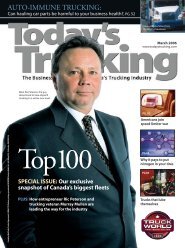You also want an ePaper? Increase the reach of your titles
YUMPU automatically turns print PDFs into web optimized ePapers that Google loves.
for a full load will bounce like crazy when<br />
empty or lightly loaded.<br />
Low-spring-rate suspensions could also<br />
help to reduce irregular wear by maintaining<br />
better contact between the tire and<br />
the road.<br />
“Air suspensions typically have a lower<br />
spring rate than leaf spring suspensions,<br />
and they maintain a relatively constant<br />
low spring rate whether the trailer is<br />
loaded or empty,” says Jim Rushe, program<br />
manager for on-highway products at<br />
Hendrickson. “Air suspensions also have<br />
shock absorbers that dampen the suspension<br />
movement, further improving the<br />
suspension’s ability to maintain tire contact<br />
with the road.”<br />
Leaf springs provide a stiffer ride on an<br />
empty trailer resulting in a varying load on<br />
the tire as it encounters irregular road<br />
surfaces, Rushe adds. “Leaf spring suspensions<br />
do not have shock absorbers, but the<br />
leaf springs themselves provide some<br />
damping characteristics.”<br />
<strong>In</strong> many high-empty-mile applications,<br />
tires and suspensions run either fully<br />
TREADING A BIT TOO LIGHTLY: Normally<br />
loaded, tires have a flat, even footprint. When<br />
empty at highway speed, the only center of<br />
the tread makes contact with the pavement.<br />
loaded or empty, so “tuning” the suspension<br />
and tire pressure to work equally well<br />
at opposite ends of the spectrum is realistically<br />
out of the question.<br />
“For air suspensions, the air pressure is<br />
used to maintain the trailer height, so<br />
changing air pressure would have little<br />
effect on the spring rate,” notes Rushe.<br />
“Leaf springs can be designed to provide<br />
varying spring rates at different loads, but<br />
the amount the spring rate can be varied<br />
is limited.”<br />
Since there are no spec’ing options to<br />
help manage this unique situation, the<br />
duties seem to fall on the maintenance<br />
department’s shoulders. Beckett sees this<br />
issue cropping up constantly in his alignment<br />
shops. He suggests the jump-in<br />
point is careful tire matching.<br />
“Mixing brands and models of casings<br />
in a dual assembly encourages irregular<br />
wear. They don’t all have the same sidewall<br />
flex,” he says. “The more focus on matched<br />
brands, models, circumference, and infla-<br />
<strong>In</strong> <strong>Gear</strong><br />
tion pressure, the better the tires will wear<br />
—even under these conditions.”<br />
And he says shock absorbers on air<br />
suspensions need particular attention.<br />
“That’s where all the damping takes place.<br />
If they’re failing, your tires will fail too.”<br />
Since your fuel costs will be lower in a<br />
half-loaded application, maybe some of<br />
the savings should be allocated to the<br />
maintenance budget. ▲<br />
How much revenue can you<br />
afford to lose? Whether it’s<br />
for billing purposes or DOT<br />
compliance, all CAT Scales are<br />
certified. CAT Scale weights<br />
are guaranteed accurate.<br />
COVER YOUR REAR<br />
with CAT Scale.<br />
CAT SCALE CO.<br />
Walcott, IA<br />
1-877-CAT-SCALE<br />
www.catscale.com<br />
®<br />
JANUARY 2010 43



